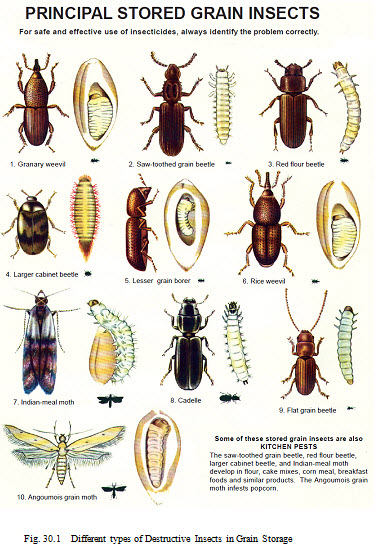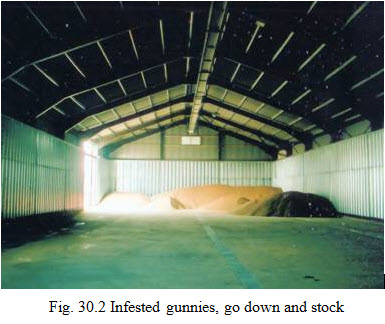Site pages
Current course
Participants
General
Module 1. Moisture content and its determination.
Module 2. EMC
Module 3. Drying Theory and Mechanism of drying
Module 4. Air pressure within the grain bed, Shred...
Module 6. Study of different types of dryers- perf...
Module 5. Different methods of drying including pu...
Module 7. Study of drying and dehydration of agric...
Module 8. Types and causes of spoilage in storage.
Module 9. Storage of perishable products, function...
Module 10. Calculation of refrigeration load.
Module 11. Conditions for modified atmospheric sto...
Module 12. Storage of grains: destructive agents, ...
Module 13. Storage of cereal grains and their prod...
Module 14. Storage condition for various fruits an...
Module 15. Economics aspect of storage
Lesson - 30. Destructive Agents
30.1 Destructive Agents in Storage
Storage of agricultural products is essential to avoid Minimization of losses, during storage of grains, due to rats, insects, diseases etc. it is essential to maintain good quality. Insect pests form one of the most important factors responsible for losses in agricultural production at various stages. Living organisms and the environment interact to bring about spoilage of stored products. Living organisms may be plant, insects, pests, man, animal, bacteria, fungi etc.
The number of insect species may be nearly one million, but only one per cent of the species may perhaps be harmful to man by consuming and contaminating the food. Insects have the capacity to adapt to any environmental condition. Several species can live in stored grain having very low moisture content. They enter into any hard-to-get-to places because of their small size. Some insects can live in darkness while some other live in light.
It is estimated that 5 to 10% of the world food production is damaged by insects during storage. The estimated losses due to insects in India, have been estimated to be around 3% of the country's production. Insects feed on the germ and endosperm causing loss in weight as well as nutrients. Besides, they cause contamination with their excreta and dead bodies. The damages can be grouped into, (1) direct damages, and (2) indirect damages.

Direct damages
(i) Some insects consume germ, some endosperm and the others eat away both. This results in loss of weight, loss or conversion of nutrients, loss of germination power, loss in gradation, and consequently fall in market value.
(ii) The contamination may be with the dead bodies, cast skin, excreta, obnoxious Odour and/or webbings.
(iii) Structures and containers 'may also be damaged by causing tunnelling in wooden parts resulting in the weakening of the structure/container.
Indirect damages
(i) It may create heating and migration of moisture.
(ii) It may create distribution of parasites to man. Certain tape worms use stored grain insects as intermediate hosts.
(iii) It causes customer's resistance/repulsion which may lower the prestige.
30.2 Agents Causing Grain Spoilage
The major physical, chemical & biological factors affecting the storage of bio-materials include:
Micro organisms
Insects, mite and pests
Rodents
Environmental factors
30.2.1 Micro organisms
Major micro organism associated with storage includes:
Fungi
Bacterial
Yeast
The activities of micro organism result in:
Color degradation
Off flavor
Moisture upgrading, wet spot & moldiness
Loss of viability, etc
30.2.2 Insects, Mite and Pests
The activity of Insects, Mite and Pests affects the storage by following ways
Insects, mites and pests attack both the stored material and wooden components of the storage structure
Weevils are the commonest insects in grains. They attack seeds and bore through them, and lay eggs in the seeds and storage structures
They reduce seed weight, quality, nutritional value and viability
30.2.3 Rodents
The Rodents affect the storage by following ways
Rodents are mammals that parasite on stored materials and attack storage structures
They eat germs of grains and waste the remaining parts
They are vectors. They also contaminate stored materials with their faeces, urine and carcasses
30.2.4 Environmental Factors
The environmental factors that mostly associated with stored products include:
Temperature
Relative humidity
Equilibrium moisture content
30.3 Sources of infestation
There are mainly five sources of infestation namely, the field itself, infested gunnies,
Infested transport, infested godown and infested stocks.
- Field
Insects may attack the crop in the field itself. Grains affected by these insects when brought to the storage centres. will be subjected to their continuous attack. The infestation may be visible or invisible. Their stocks should, therefore, be fumigated immediately on receipt.
- Infested gunnies
Even if sound and new gunnies are used for packing the newly harvested grains, the insects hiding in the seams of the gunnies will attack the freshly harvested stocks. The gunnies should be fumigated before packing the freshly harvested grains:
- Infested transport
The transport used for carrying the newly harvested stocks should invariably be sprayed with DDVP or malathion. If the transport like bullock cart or tractor trolley has been used for carrying infested stocks on the " previous occasion, the left over insects may attack the stocks now loaded into them.
- Infested godowns
Even if the stocks are moved to a freshly taken over godown, it is not free from trouble. The insects present in the cracks and crevices of the wall or that hibernate in the structures, may emerge out and attack the grains. Hence the cracks and crevices should be plugged and empty godowns should be thoroughly cleaned and fumigated.
- Infested stocks
In case sound stocks are brought to a godown where infested stocks are in storage, cross infestation takes place

References:
-
A Text Book Unit Operations of Agricultural Processing by K.M Sahay and K.K.Singh
-
FAO Corporate document Respiratory Produced by Agriculture and consumer Protection
-
Post harvest physiology of perishable plant products by Stanley J. Kays (664.7)
-
Handling and Storage of Food Grains by S.V.Pingale